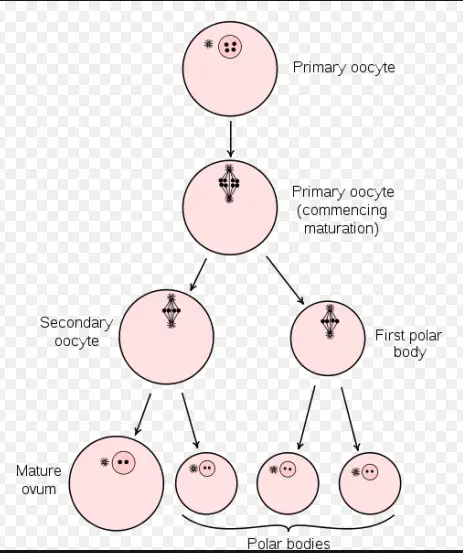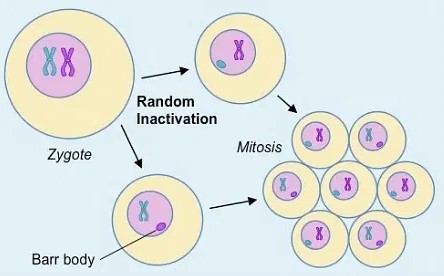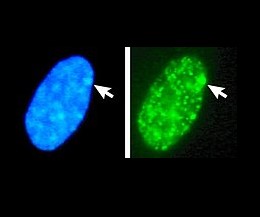Genetic variations are the cornerstone of biological diversity and adaptation, influencing not only individual traits but also susceptibility to various diseases. Among these variations, the concepts of Barr bodies and polar bodies stand out for their unique roles in genetic expression and reproductive biology. These cellular structures, while distinct in function and formation, both play critical roles in the transmission of genetic information from one generation to the next.
A Barr body is an inactivated X chromosome found in the cells of females, serving as a key mechanism for dosage compensation between males and females. On the other hand, polar bodies are small cells produced during the female gamete’s development, primarily serving to discard the extra set of chromosomes, ensuring the resulting egg has a single set for fertilization. These processes are crucial for maintaining genetic stability and diversity within populations.
The distinction between a Barr body and a polar body lies not only in their physical characteristics and formation but also in their genetic and functional implications. Barr bodies are a manifestation of genetic regulation, ensuring equal gene expression between sexes, whereas polar bodies are a byproduct of meiotic division, critical for healthy embryonic development. Understanding these concepts provides insights into fundamental genetic processes that govern development, inheritance, and even some genetic disorders.

Barr Body Explained
Overview
A Barr body is an inactivated X chromosome found in the nuclei of female cells. This phenomenon plays a crucial role in genetic balance, ensuring that males and females have an equal dosage of the genes located on the X chromosome. Despite its small size, the Barr body is a powerhouse of genetic regulation, pivotal for maintaining genetic equilibrium between the sexes.
Formation Process
The formation of a Barr body is a fascinating process that occurs early in embryonic development. Here’s how it happens:
- Random Inactivation: In females, one of the two X chromosomes in each cell is randomly chosen to be inactivated during early development. This choice is random, meaning that it can be either the maternal or paternal X chromosome.
- DNA Condensation: The chosen X chromosome undergoes condensation, tightly wrapping its DNA around histone proteins. This process dramatically reduces its activity, effectively silencing the majority of its genes.
- Maintenance: Once inactivated, this chromosome remains as a Barr body within the nucleus of cells, passed down through subsequent cell divisions. It is only reactivated in the cells that form the eggs, ensuring they can pass on a functional X chromosome to the next generation.
Role in Genetics
The Barr body is essential for dosage compensation — a mechanism to equalize the gene expression of X-linked genes between males (XY) and females (XX). This balance is vital for normal development and function, preventing females from having twice the amount of X chromosome gene products as males. It also plays a role in the manifestation of certain genetic diseases, such as X-linked recessive disorders.
Polar Body Overview
Definition
A polar body is a small cell byproduct formed during the oogenesis, the process of egg development in females. Unlike the Barr body, polar bodies are involved in reproductive biology, particularly in the distribution of chromosomes during gamete formation. They ensure that the egg has the correct amount of genetic material for fertilization.
Formation during Meiosis
The formation of polar bodies is integral to the development of a healthy egg:
- First Division: During the first meiotic division, the primary oocyte divides into two cells: a large secondary oocyte and a small polar body. This division is asymmetrical, ensuring that the secondary oocyte retains most of the cytoplasm.
- Second Division: The secondary oocyte can undergo a second meiotic division following fertilization, producing another polar body. The primary polar body may also divide, resulting in up to three polar bodies, which eventually degenerate.
Function in Reproduction
Polar bodies serve several key functions in reproduction:
- Chromosome Disposal: They allow the egg to dispose of excess chromosomes, maintaining the necessary haploid state for fertilization.
- Genetic Screening: The formation of polar bodies can be indicative of the egg’s chromosomal health, providing a non-invasive means of genetic screening.
Key Differences
The Barr body and polar body, while both critical to genetics and reproduction, have distinct differences that set them apart:
Physical Characteristics
- Barr Body: A compact structure within the nucleus, visible under a microscope as a dense, dark spot against the nuclear envelope.
- Polar Body: Small, cytoplasmic extrusions from the egg that are often hard to detect without specialized equipment.
Formation Timing
- Barr Body: Forms during early embryonic development and remains through the individual’s life in somatic cells.
- Polar Body: Formed during oogenesis, specifically at the times of meiotic divisions.
Genetic Composition
- Barr Body: Contains a full set of X chromosome genes, although in an inactivated state.
- Polar Body: Carries a haploid set of chromosomes, which are essentially duplicates of those retained by the egg or discarded.
Functional Roles
- Barr Body: Ensures dosage compensation across sexes for X-linked genes, contributing to genetic balance and disease manifestation.
- Polar Body: Plays a role in reproductive biology by ensuring the egg has the correct number of chromosomes for fertilization, and potentially serves as a means for genetic screening.

Formation and Development
Barr Body Formation
The formation of the Barr body is a critical process in the early development of female mammals, ensuring genetic balance by compensating for the extra X chromosome. This process involves several key steps:
- Cell Differentiation: Early in embryonic development, cells start to differentiate. It’s during this time that one of the two X chromosomes in each cell of a female embryo is randomly selected for inactivation.
- Xist RNA Activation: The X-inactivation specific transcript (Xist) gene on the X chromosome to be inactivated becomes highly active, producing Xist RNA. This RNA coats the chromosome, initiating the inactivation process.
- Chromosome Condensation: Following the spread of Xist RNA, the X chromosome undergoes condensation, tightly packing its DNA and histones, leading to its inactivation. This condensation transforms the chromosome into a Barr body.
- Maintenance Through Cell Division: The inactivated X chromosome, now a Barr body, is maintained in this state through subsequent cell divisions. It replicates along with the active chromosomes but remains condensed and largely inactive.
Polar Body Development Process
The development of polar bodies is an integral part of oogenesis, or egg formation, in females. This process ensures that eggs have the correct genetic material for fertilization. The steps include:
- Primary Oocyte Division: The primary oocyte undergoes the first meiotic division, resulting in two cells: a secondary oocyte and a first polar body. This division is asymmetrical, allocating most cytoplasm to the secondary oocyte.
- Secondary Oocyte Division: If fertilization occurs, the secondary oocyte proceeds through the second meiotic division, producing a mature ovum and a second polar body. The first polar body may also divide, potentially creating two additional polar bodies.
- Chromosome Disposal: Through these divisions, polar bodies serve to discard the extra set of chromosomes, ensuring the ovum is haploid, with a single set of chromosomes ready for fertilization.
Genetic Significance
Chromosome Inactivation
Chromosome inactivation, specifically X-chromosome inactivation (XCI), is a marvel of genetic regulation. XCI balances the expression of X-linked genes between males and females, preventing females from having a double dose of gene products. This process:
- Ensures Dosage Compensation: Balancing gene expression across sexes for genes located on the X chromosome.
- Involves Epigenetic Modifications: Changes to the DNA and histones of the X chromosome that do not alter the DNA sequence but affect gene expression.
- Is Random and Permanent: Once an X chromosome is inactivated in a cell, it remains inactivated in all descendant cells.
Genetic Diversity and Evolution
Both Barr bodies and polar bodies contribute to genetic diversity and evolution in unique ways:
- Barr Bodies ensure genetic diversity within female populations by randomly inactivating one of the two X chromosomes, leading to mosaicism. This can influence the manifestation of X-linked traits and diseases.
- Polar Bodies play a crucial role in sexual reproduction, contributing to genetic diversity through meiosis. They ensure that each ovum carries a unique set of genes, which, when combined with sperm, increases genetic variation among offspring.
Clinical Implications
Impacts on Health
The formation and function of Barr bodies and polar bodies can have significant impacts on health, particularly in relation to genetic disorders:
- X-Linked Disorders: Barr bodies play a role in the expression of X-linked genetic disorders. In females, the presence of a Barr body means that they can be carriers of diseases like Hemophilia and Duchenne Muscular Dystrophy without showing symptoms, due to the inactivation of one X chromosome carrying the defective gene.
- Infertility: Abnormalities in polar body formation can lead to issues with egg development and fertility. For example, errors in meiosis can result in aneuploid eggs, which are a leading cause of miscarriage and developmental disorders.
Diagnostic Uses
Both Barr bodies and polar bodies have important diagnostic uses:
- Barr Body Analysis: The presence or absence of Barr bodies in a cell can be used in genetic testing to determine the sex of an individual, diagnose disorders of sex development, and identify carriers of X-linked diseases.
- Polar Body Biopsy: This technique involves removing and analyzing polar bodies from an egg to assess its genetic health without disturbing the egg itself. It can be used in assisted reproductive technologies (ART) to select genetically viable eggs, reducing the risk of genetic disorders and improving the success rates of in vitro fertilization (IVF).
FAQs
What is a Barr Body?
A Barr body is an inactivated X chromosome visible in the nucleus of somatic cells of female mammals. This phenomenon, known as Lyonization, occurs randomly in early embryonic development, ensuring that females, like males, have a single active X chromosome in each cell. The presence of a Barr body is crucial for balancing gene dosage between males (XY) and females (XX) and has implications for understanding X-linked genetic conditions.
How is a Polar Body Formed?
Polar bodies are formed during the process of oogenesis, the development of the female gametes, or eggs. During meiosis, the precursor egg cell divides asymmetrically to produce a larger secondary oocyte and a smaller polar body. This division helps to ensure that the egg retains most of the cytoplasmic content, while the polar body primarily serves to discard an extra set of chromosomes, maintaining the haploid state necessary for fertilization.
Why Are Barr Bodies and Polar Bodies Important?
Barr bodies and polar bodies are essential for maintaining genetic stability and diversity. Barr bodies ensure that females, with two X chromosomes, do not have a double dose of X-linked genes compared to males with a single X. Polar bodies, on the other hand, play a critical role in reproductive biology by ensuring that the egg and, consequently, the zygote, have the correct number of chromosomes. Both structures are key to understanding genetic diseases, developmental biology, and the mechanisms of inheritance.
Conclusion
The study of Barr bodies and polar bodies offers fascinating insights into the complex mechanisms that govern genetic expression and reproductive biology. By understanding the differences and roles of these cellular structures, scientists and researchers can delve deeper into the mysteries of genetics, from how traits are inherited to the development of strategies for treating genetic disorders. These insights underscore the importance of genetic stability and diversity as fundamental components of life.
Moreover, the exploration of such genetic phenomena highlights the intricate balance within biological systems, where even the smallest components can have profound implications for the health and viability of organisms. As we continue to uncover the secrets of genetics, the knowledge gained from studying Barr bodies and polar bodies will undoubtedly contribute to advancements in medicine, biotechnology, and our understanding of the natural world.

